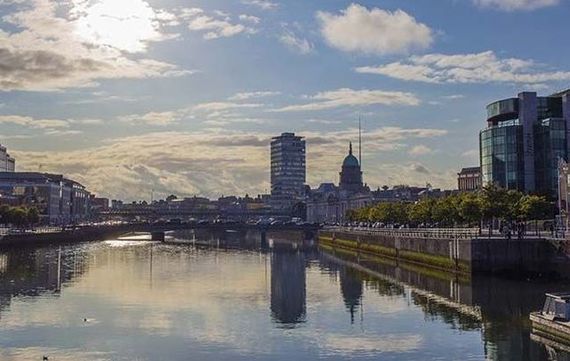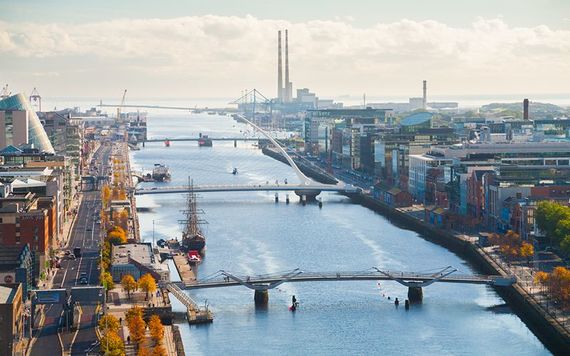Those who love the gentle skyline of dear old Dublin have been shocked by the decision to grant permission for a Manhattan-style tower block in the center of the capital
Even as the city expanded over the last 50 years or so, new buildings were kept at a relatively low level, one well-known exception being the new incarnation of the historic Liberty Hall, the trade union headquarters. That was built in the 1960s, an ugly 13-storey "modern" glass block on the Liffey which towered over everything else.

Dublin's Liberty Hall.
The recent boom added a few other monstrosities of similar scale, mainly further down the river as the crumbling docklands were turned into the city's new financial and high tech areas. But the city center itself remained low rise and its character was largely preserved.
That is now changing. A new 22-story block is to be built at Tara Street across the river from Liberty Hall and a stone's throw from Trinity College and the GPO on O'Connell Street where the Easter Rising began.
It's not quite the city center but it's close. This has led to anguished cries here about skyscrapers turning Dublin into another Manhattan.
I don't have to tell you guys in the Big Apple that a 22-story block is a mere tiddler by Manhattan skyscraper standards. But that has not lessened the concern here that this could be the start of a new direction that will destroy the human scale of Dublin and darken the city's lovely skyline forever.
No one thinks this will be the last high rise block in the city center when it goes ahead. Numerous such blocks in the city center are sure to follow.
The new direction has been made possible thanks to a shift in policy by our young minister for housing and planning, Eoghan Murphy, who is under intense pressure because of the housing crisis. The shift means that major developments can now bypass local councils (in this case the city council) and go straight to the national planning board for permission.
The aim is to speed up the process and avoid time wasting objections from NIMBY (Not In My Back Yard) locals. Critically, the height restrictions that were there for so long have been removed.
We desperately need extra housing in the city, and supporters of the change say that building high will be far better for all those people who work in the city but have to live in distant suburbs and towns and commute long distances every day. The critics point out that this new block is for offices and a hotel, not homes. But a shift to high rise in the city will inevitably mean high rise housing as well as offices in the future.
Whether this is a positive development or not is arguable. At present Dublin would still be recognizable to James Joyce if he was to walk around it more than a century after the day in the city he portrays in Ulysses.
An aerial view of Dublin's river Liffey by the modern Silicon Blocks.
If we lose that, we will be much the poorer. The answer surely must be to keep high rise developments outside the city center rather than have them mushroom all along the river through the heart of Dublin.
That was the intention of the city planners who decided a few years ago that some high rise developments could be allowed in the lower docklands and also at the upper section of the Liffey around Heuston Station, book-ending the low rise city in between and preserving it for the future. In the city center, a maximum height of nine stories would be allowed but those buildings would only be at exceptional sites.
In practice the norm for new blocks has been five or six stories. That policy was turned on its head last year when the minister issued a directive to councils telling them to stop limiting the height of buildings.
We have yet to see the full effect this will have on the city over the next few years, but the new 22-story block at Tara Street may well be a sign of what is to come. It's the brainchild of the celebrity developer Johnny Ronan, who became the poster boy of the building boom here a decade ago before he went bust in the crash. Like a few of the other big developers from that crazy era he is now back, supported by international investors, and cranes are once again crowding the skyline over the city.
This has led to growing anxiety that we could be heading into another building boom that could go wrong again -- this time after wreaking havoc in the city center. An Taisce, the national conservation organization in Ireland, has called the decision to give permission for the Tara Street block "a catastrophic error which undoes decades of planning control in Dublin." It says it will "irrevocably damage the city's irreplaceable character."
It would be wrong to think that everyone here is against high rise development. The desperate shortage of housing is seen by many as sufficient justification for the shift, particularly by young IT workers in the likes of Google and Facebook who are currently paying astronomical rents to live in the city. But it's far from certain that what we will get is affordable apartments rather than more office space and hotels.
Even if it does provide more accommodation in the city, is it really the best way to go? We have bitter experience from the Ballymun flats a few miles from the city center.
These eight-story blocks were built as public housing by the council in the 1960s and turned into a disaster of anti-social behavior and drugs and were eventually demolished. A lot of international research shows that the optimum height for apartment blocks, especially those housing families, is four or five stories, and they are also cheaper to build and maintain.
The other argument in favor of 20, 30 or even 40-storey tower blocks here is that they would be a visible reflection of the transformation of Dublin into a young vibrant city where high tech meets design and contemporary culture. These statement blocks would point to the future, the argument goes, rather than confining us forever to the past.
The soaring U2 Tower was one of several such proposed blocks on the river that never happened because of our timidity and our lack of vision, it is claimed. Instead of the kind of statement buildings you see in London or New York, we confined ourselves to five or six storey blocks that are anonymous and boring, these critics say. Even in the docklands along the lower Liffey where we had a glorious opportunity to show what we could do, we have ended up with what one writer calls "stump city."
So where does all this leave us? Who will win the debate about the future of Dublin and whether it should be allowed to became a high rise city?
It's too early to say, although the fact is that the minister's directive to local councils to move away from height limits has upped the game. That could change again in the future, of course, but for the time being we are into uncharted territory.

A view of Dublin city along the Liffey.
As always with such changes there are unforeseen consequences. Rather than speeding up the supply of accommodation in the city, for example, the new freedom to build higher may tempt some developers who have already got permission for apartment blocks to go back again and seek approval for a few more stories on top. That could add a year or two to these apartments becoming available.
This is already happening, and not just in the city center. In the fishing village of Howth on the north side of the city, planning permission exists for several blocks of apartments to be built on a former industrial site beside the harbor. The spectacular site is on the beach and the blocks range up to six stories.
But there is no sign of construction work starting after years of delays, and the suspicion is that an attempt is now underway to get permission to make the development much higher. In a small seaside village which is a major tourist attraction this is controversial, to say the least. But it may well succeed.
The truth about all this is that allowing high rise development in the city center would have only a marginal impact on our housing crisis. Using the crisis as an emotive reason for pushing through high rise development is bogus.
Trying to turn Dublin, an old city with many winding narrow streets, into another Manhattan is never going to be a good idea.
Do you think that high-rise buildings should be allowed in Dublin's city center? Let us know in the comments section below.
Read more: Ireland’s big street begging scam




Comments